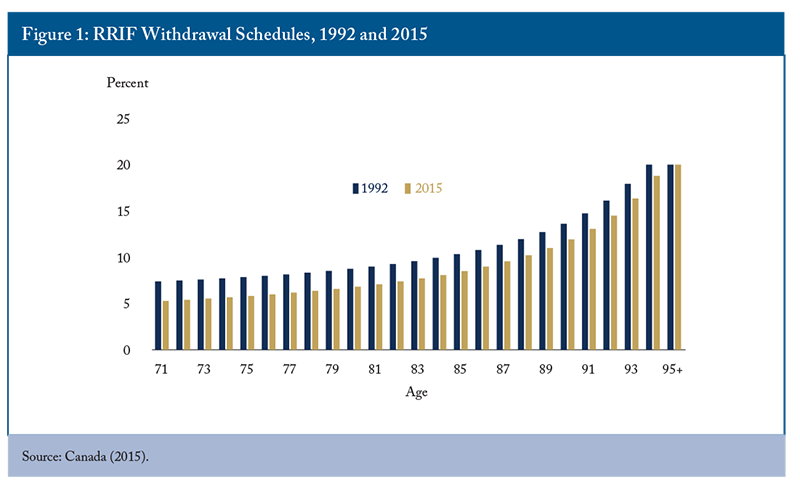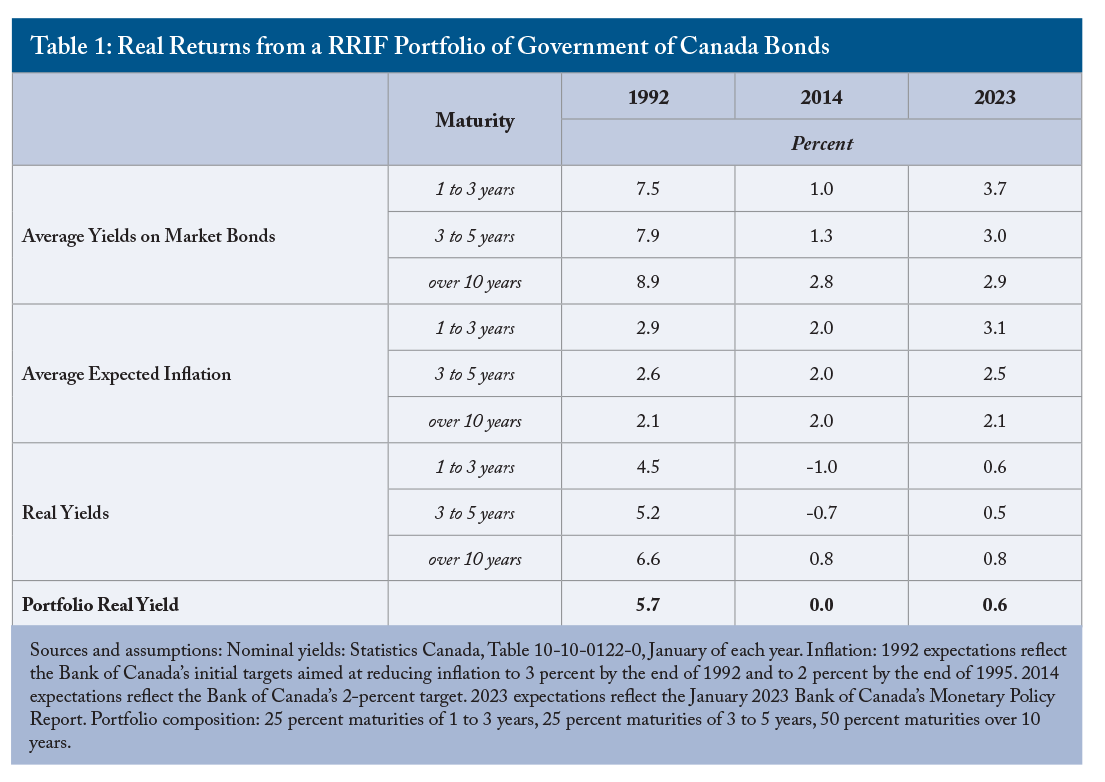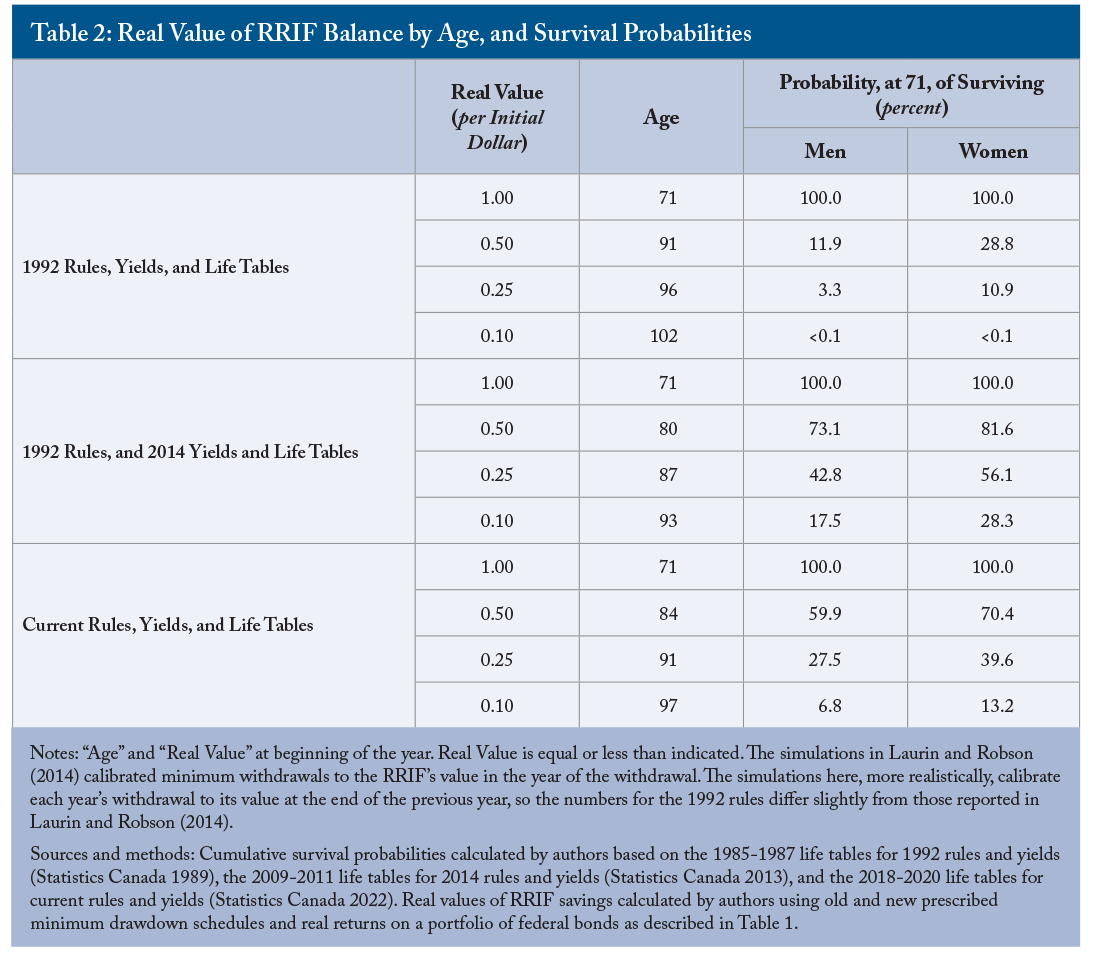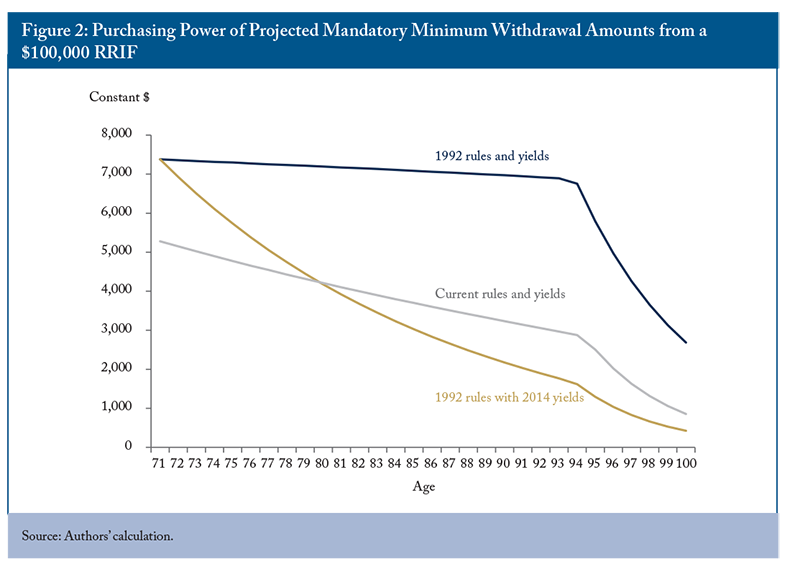The Study In Brief
- Tax rules requiring RRIF withdrawals need revamping. Longer lives and lower returns increase the likelihood that mandatory minimum withdrawals will leave seniors with negligible income from their tax-deferred saving in their later years.
- Government impatience for revenue should not force holders of RRIFs and similar tax-deferred vehicles to deplete their nest eggs prematurely. We need to ensure that minimum withdrawals and the ages at which saving must stop and withdrawals must start reflect updated demographic and economic realities.
- The complexities of formula-based approaches and frequent updates suggest more far-reaching approaches, including abolishing age limits and minimum withdrawals altogether. Another withdrawal-reform option would eliminate the requirement to withdraw amounts below a certain threshold value – say $8,500 – to avoid premature depletion of nest eggs.
We thank Daniel Schwanen, Jeremy Kronick, Bob Baldwin, Derek Dobson, Bonnie-Jeanne MacDonald, Eric Monteiro, James Pierlot, Michael Veall, Kevin Wark and the numerous people who read and commented on our previous work on this topic (Robson 2008; Robson and Laurin 2014). We take full responsibility for any errors and for the conclusions and policy recommendations.
The RRIF Challenge
Tens of millions of Canadians are saving in tax-deferred accounts, or are drawing from those accounts to support themselves in retirement. Except for the minority in defined-benefit (DB) pension plans, these savers are using capital accumulation plans (CAPs), such as Registered Retirement Saving Plans (RRSPs) and defined-contribution (DC) pension plans. Seniors are drawing those savings down, predominantly from registered retirement income funds (RRIFs).
RRIF holders face a challenge: balance their need for current income against the risk of outliving their savings. The federal Income Tax Act complicates this challenge. It obliges some DC plan members when they retire, and all CAP savers no later than the end of the year they reach age 71, to buy annuities, or transfer their assets into RRIFs.
The Background: RRIFs and the framework for withdrawals from them date from 1978. Before then, RRSP holders had to either buy a life annuity from an insurance company with their RRSP funds, or withdraw the funds all at once, paying any resulting tax, in the year they turned 71. The 1978 federal budget created the RRIF regime, which allowed RRSP holders to continue to manage their investments on a tax-deferred basis, “while retaining the basic principle that RRSP funds are intended to be used for retirement income (Canada 1978).”
The withdrawal formula established in 1978 obliged RRIF holders to withdraw an amount each year equal to the value of the fund at the beginning of the year divided by the number of years remaining before the holder (or the holder’s spouse) reached the age of 90. Recognition that this aggressive schedule, which exhausted RRIF accounts after age 90, put too many seniors at risk of depleting their tax-deferred savings prompted a change in 1992. The 1992 rules extended the formula to require steadily increasing withdrawals until the year in which the holder turned 95, at which point the annual withdrawal became 20 percent of the remaining value of the fund.
The 1996 federal budget reduced the age at which saving in DC pension plans and RRSPs must stop from 71 to 69 – one among many measures, including lowering and freezing maximum contributions, to bring in more revenue and reduce the deficit. The 2007 budget put the age back to 71.
Since the 1992 changes to the minimum withdrawal schedule, the federal government has recognized the problem mandatory RRIF withdrawals create for seniors three times. Two of them were occasions when financial market declines made the problem acute. The government temporarily reduced mandatory withdrawals in response to the 2008 financial crisis. It did it again when COVID-19 hit markets in 2020. But those episodes merely highlighted a chronic problem that remained after the temporary relief expired. Indeed, the problem has generally become worse over time because post-retirement longevity has been increasing even as returns on assets yielding reliable cash flows that are suitable for most retirees have fallen. Longer lives and lower returns increase the likelihood that the mandatory withdrawals will leave significant numbers of seniors with negligible income from their tax-deferred saving in their later years.
The third post-1992 change alleviated pressure on people’s registered savings in a more lasting way. In 2015, the federal government revamped the minimum withdrawal schedule established in 1992. The 2015 schedule is still in effect. Its minimum withdrawals are almost one-quarter smaller at age 71 than the previous ones. They gradually converge with the old ones, however. Notably, the 2015 changes left the ages at which saving must stop and withdrawals must start at 71 and 72, and only raised the age at which the drawdown schedule jumps to 20 percent annually by one year (Figure 1).
The 2015 changes, though helpful, fell short of what changes in longevity and investment returns since 1992 would have suggested. Moreover, lifespans have improved since then, while investment returns remain low. It is time for a fresh look at these rules. A respectable case exists for establishing an exemption threshold for which withdrawals below a specified value are not mandatory, or even abolishing mandatory withdrawals entirely. In any event, the ages at which saving must stop and withdrawals begin should rise, and the minimum withdrawals should shrink again. Otherwise, too many seniors will live long enough to see the purchasing power of their tax-deferred savings dwindle to insignificance.
Longevity, Investment Returns, and the Risk of Outliving Tax-Deferred Saving
To show how the RRIF withdrawal rules interact with longevity and returns on investment, we compare three situations:
(i) 1992, after the first set of changes to the 1978 drawdown schedule;
(ii) 2014, when longer lifespans and lower returns had created pressure for reform;
(iii) Now, with the 2015 rules, and current returns and lifespans.
The 1992 Scenario: The foundation of the 1992 rules was a calculation that a RRIF holder should receive an income stream that grew 1 percent annually until age 94, to provide some protection from inflation (Canada 1992, 143), assuming a 7 percent nominal return on RRIF assets (Canada 2015, 446-47). Although inflation targeting was relatively new and unproven in 1992, that nominal return assumption presumed reasonable returns in real terms. The nominal yield on a portfolio of government of Canada bonds with maturities roughly matching expected drawdowns, adjusted for the inflation rates anticipated in the Bank of Canada’s inflation-reduction targets at the time, produced a prospective compound real rate of return of about 5.7 percent (Table 1, 1992 column).
A few simplifying assumptions let us calculate how these returns interact with a minimum withdrawal schedule to determine the real value of a typical retiree’s nest egg over time. Suppose birthdays, retirements, and RRIF distributions all occur at year-end. With the yields available in 1992, the real value of a dollar in a RRIF at the end of the year the account holder turned 71 would drop below 50 cents by the end of the year s/he reached age 91. It would drop below 25 cents by the end of the year s/he reached age 96, and below 10 cents by the end of the year s/he reached age 102.
In 1992, the odds that this person would experience those depletions were low. The life tables available then gave a 71-year-old man about a one-in-eight chance, and a 71-year-old woman about a one-in-four chance, of surviving to age 91, the year the nest-egg’s real value would have fallen by half (Table 2, first panel).

three-quarters – the odds were 1 in 30 for a man, and 1 in 9 for a woman. The odds of reaching age 102 – the year its value would drop 90 percent – were negligible for either sex. So these minimum withdrawals would have presented most retirees with no serious threat to sufficient tax-deferred funds in very old age.
The 2014 Scenario: By 2014, however, lower yields on safe investments had markedly changed the impact of the 1992 rules. At the beginning of that year, the bond portfolio described above yielded nothing in real terms (Table 1, 2014 column). That meant the retiree would hit the thresholds for nest-egg depletion just described much sooner (Table 2, second panel). The real value per initial dollar in the nest egg would drop below 50 cents by the end of the year s/he reached age 80 (compared to age 91 in 1992). It would drop below 25 cents when s/he reached age 87 (compared to age 96 in 1992), and below 10 cents when s/he reached age 93 (compared to age 102 in 1992).
Increased longevity makes these numbers more unsettling. The life tables available in 2014 put the life expectancy of a 71-year-old man at 14.4 years, up from 11.2 in 1992, and of a 71-year-old woman at 16.9 years, up from 14.6 in 1992 (Statistics Canada 2013). As the second panel in Table 2 shows, the likelihood of living to see the real value of tax-deferred savings fall by half had risen to 3 in 4 for a man (up from 1 in 8), and more than 4 in 5 (up from 1 in 4) for a woman. The chances of seeing its real value fall by three-quarters had risen to 2 in 5 (up from 1 in 30) for a man and closer to 3 in 5 (up from 1 in 9) for a woman. And the chances of seeing its value fall by 90 percent had gone from negligible to appreciable: about 1 in 6 for a man, and worse than 1 in 4 for a woman.

The Current Scenario: Although the 2015 changes alleviated some of the pressure of mandatory withdrawals on tax-deferred saving, similar projections using current yields and life expectancies reveal a continuing problem. Real returns on safe assets are still very low. Even if we look past recent 6-percent-plus inflation and assume expectations match the projections in the January 2023 Bank of Canada’s Monetary Policy Report, the real yield on our simulated portfolio of Canadian government bonds is a modest 0.65 percent (Table 1). And the most recent life tables (2018-2020) show that Canadians continued to live progressively longer after the 2015 RRIF changes.
Under the current rules, real yields, and longevity assumptions (Table 2, third panel), a 71-year old of either sex will likely live to see the real value of an initial dollar in a RRIF fall below 50 cents. It happens at age 84 – an age 6 in 10 men, and 7 in 10 women, can expect to reach. Its real value falls below 25 cents at age 91 – an age 3 in 10 men, and 4 in 10 women, can expect to reach. And its real value falls below 10 cents at age 97 – which about 1 in 15 men and 1 in 7 women can expect to reach.

Though better than the 1992 ones, the current minimums are still too big. Without lowering the withdrawal percentages further – or using the more powerful tool of raising the age at which withdrawals must start – today’s seniors have a far higher chance of living to see severe depletion of their RRIF nest-egg’s purchasing power than the 1992 rules contemplated.
Implications for the Purchasing Power of RRIF Withdrawals
The implications of these rules for the living standards of seniors emerge starkly from examining the real value of the minimum withdrawals themselves: the purchasing power the RRIF holder enjoys from the distributed amounts (Figure 2).
Suppose the real value of the nest egg were $100,000 at the end of the year its holder turned 71. Under the rules and conditions of 1992, the annual minimum withdrawals would have had a real purchasing power around $7,380 at the outset, and would have dropped about $25 annually, down to about $6,760 by age 94 (the blue line). The gold standard for an annuity would be constant purchasing power throughout the recipient’s life – like the indexed pensions received by former federal public servants and Members of Parliament. The 1992 withdrawal schedule did not do that, but the purchasing power of the withdrawal at age 94 was only about 8 percent lower than the purchasing power of the withdrawal at age 71. After age 94, the purchasing power of the withdrawals declined much faster – but 30 years ago, very few people anticipated living that long.
With the 1992 rules and the yields available before the 2015 changes, the real value of the withdrawals would have dropped about $250 annually, down to about $1,620 by age 94 (the red line). That represents a decline in purchasing power of more than three-quarters by an age that, according to the then-current life tables, more than 1 in 6 men age 71, and more than 1 in 4 women age 71, could expect to reach. To the extent that a financially unsophisticated RRIF holder set his or her course for retirement on the assumption that the early years’ real income from withdrawals was sustainable, this rapid drop in their purchasing power could create hardship.
Re-run those numbers with the post-2015 withdrawal schedule for a RRIF with a starting value of $100,000, and a real return of 0.65 percent, and the withdrawals’ real value begins falling by about $105 annually, down to about $2,875 by age 94 – a decline of almost half (the purple line). Nowadays, about 1 in 8 men age 71 and 1 in 5 women age 71 can expect to reach age 94 – and, of course, those who live past that age see the purchasing power of their withdrawals drop precipitously. As a guide to allocating post-retirement income, this is marginally better than the 2014 scenario, but that is the best one can say. It is not good. No one would design a DB pension plan that promised an annuity with a time profile like that – and if someone did, no one would want to participate in it. Yet that is what the RRIF rules implicitly propose.
Is the real return we assume for a retiree’s tax-deferred assets too low? We are at least as vulnerable to a charge of assuming returns on safe assets that are too high. We ignore costs, which for a retail investor can subtract one or two percentage points from the yield on the underlying asset. In particular, assets that provide inflation protection are in short supply – a problem that will get worse if the federal government maintains its recent – and peculiar – pledge to cease issuing real-return bonds.
What about assets that are less safe, and/or have cash flows less well matched to a retiree’s needs? A portfolio of shares, and other less-than-sovereign-grade assets, could produce capital gains over time. But it also could, and at intervals inevitably will, suffer losses. People who are advanced in years are ill-placed to endure losses. When they do, moreover, mandatory drawdowns amplify the consequences, since they force asset sales regardless of the state of the market, obliging their holders to realize losses – which is why the government reduced the minimum withdrawals in 2008 and 2020. A retiree seeking a real return high enough to reduce the chances we calculate of outliving her or his nest egg could not do it using the kind of safe assets that are appropriate to most seniors.
Mandatory RRIF Withdrawals: The Benefits and Costs
Why force RRIF holders to draw down their savings at all? A key motivation for the government from the inception of this regime has been to accelerate receipt of revenue by limiting the period of time over which people can defer taxes. The subsequent establishment of income-tested clawbacks of Old Age Security (OAS) benefits made that fiscal motive all the more compelling for the government.
Forcing people to take income that will push them into higher tax brackets and trigger clawbacks they might otherwise be able to avoid is inequitable.

Annual income is a defective basis for assessing liability for taxes and eligibility for transfers to begin with, since people with similar lifetime incomes often have different earning patterns that expose them to higher or lower average tax rates. A retiree with an indexed annuity from a DB pension plan could have a higher cumulative income in retirement than a RRIF holder, but escape higher income-tax rates and OAS clawbacks because the real value of the annuity’s payments is level over time. The RRIF holder’s front-loaded withdrawals (as in the Figure 2 example) could subject her to higher rates and clawbacks, even though her cumulative income in retirement would be less.
Moreover, deferred taxes are deferred, not eliminated. Income tax will be due at some point – either when the RRIF holder would have voluntarily withdrawn the savings, or when she or he died. In that sense, the deferred taxes in these accounts are implicit assets for governments. If the average applicable tax rates are the same, the mandatory minimums do not affect the present value of withdrawals; they simply make them happen sooner. That impatience for revenue is hard to justify. Governments are, for practical purposes, immortal. The timing of receipts and payments matters less to them, unless unsustainable deficits require their immediate reduction, as in the mid-1990s.
The minimum withdrawals are not a serious problem for those who, perhaps because they do not expect to live long, want to draw their tax-deferred savings down faster than the minimums require. Others, willing and able to work and replenish their savings after age 71, will get by. Couples whose ages are very different can benefit from gearing their withdrawals to the younger spouse’s age. High-income seniors whose incremental withdrawals do not by themselves trigger OAS clawbacks will find the burden of paying ordinary income taxes on them tolerable. Higher TFSA limits will also let more seniors reinvest unspent withdrawals in them, avoiding repeated taxation.
For others, however, forced withdrawals are a problem. The option of working more is not realistic for many seniors, and impossible for those at very advanced ages. As noted already, the front-loaded value of withdrawals subjects some people to higher tax rates and OAS clawbacks than other people with similar cumulative post-retirement incomes. Many people, especially as they get older, find tax planning daunting, and are more prone to making investment mistakes and falling victim to scams. Some people treat the financial parameters of, or defaults in, retirement savings programs as a nudge guiding them as to what they should draw down, even when they should not.
More generally, foreseeable demands on individual and public resources suggest that encouraging or forcing dis-saving is a bad idea. The RRIF schedule guarantees diminishing purchasing power of their withdrawals over time. Although older people tend to spend less on items such as recreation and travel as time goes by, many will, at some point, face higher expenses for items such as home- or long-term care. People are not identical. Their life expectancies differ.
Mandatory RRIF Withdrawals Should Shrink or Disappear
A striking lesson of the experience since the inception of the mandatory conversion and withdrawal regime in 1978 is how much has to change before its rules do. Aside from the temporarily lower minimum withdrawals in 2008 and 2020, and the lower ages for conversion and drawdown from 1996 to 2007, only two lasting changes have occurred in the half century since then, and they did less than they could have. The 1992 changes extended the drawdown period past age 90, but left the initial ages unchanged. The 2015 reforms did not adjust the drawdown schedule enough to offset changes in longevity and investment returns since 1992, and also left the initial ages unchanged.
One pair of options for immediate action would be raising the initial ages and the age at which minimum withdrawals rise to 20 percent annually. If each age had adjusted with increases in life expectancy since 1992, they would now be about three years higher. So phasing in higher ages over a short period would make sense.
Since experience to date suggests that periodic changes are rare and reviews might be inadequate, more regular reviews might be better. Minimum withdrawals could vary more frequently as longevity and yields on safe assets change. As useful would be regular updates of the ages at which saving must stop and withdrawals must start, and the age at which minimum withdrawals become 20 percent. A more sophisticated approach could gear minimum withdrawals to the current cost of annuities. The trick would be to establish formulas and schedules that would keep the regime reasonably current for the average retiree without making retirement planning more confusing and unpredictable than it already is.
An intermediate approach would be review at frequent intervals – every three years, say – with a commitment to avoid changes of more than a given size. Although changes in age thresholds and drawdowns would reflect changes in life expectancy and investment returns only with a lag, retirees and their advisors would benefit from greater medium-term certainty.
Like the current regime, however, any single rule would continue to subject the entire population of CAP savers to a one-size-fits-all regime. Especially as the population of seniors grows, its heterogeneity is something that needs acknowledgement and respect – including the varying willingness and ability of seniors to work and plan for retirement, and the different life expectancies confronting different people.
The evident difficulty of updating the rules legislatively, the complexities of formula-driven approaches, and problems of a one-size-fits all approach point towards the straightforward option of eliminating mandatory withdrawals altogether. If complete elimination is not politically feasible or persuasive, another option would be to eliminate the requirement for withdrawals below a certain value – $8,500, say indexed to inflation
For the government, full or partial elimination of minimum withdrawals would delay the income it would get by taxing and clawing back benefits in respect of these funds, but in present-value terms, the fiscal impact would likely be small.
Government impatience for revenue should not force holders of RRIFs and similar tax-deferred vehicles to deplete their nest eggs prematurely. At a minimum, we need age thresholds and RRIF withdrawal minimums that reflect updated demographic and economic realities. Ages at which saving must stop and withdrawals must start and accelerate should be higher. Minimum withdrawals below a certain threshold could end, and the whole regime of minimum withdrawals could disappear. All these options would give Canada’s seniors a better chance of enjoying long life and prosperity – the post-retirement security they save for.
References
Brown, J. R., Poterba, J., and Richardson, D. P. 2017. “Do required minimum distribution rules matter? The effect of the 2009 holiday on retirement plan distributions.” Journal of Public Economics 151, 96-109.
Canada. 1978. “The Budget.” Ottawa: Department of Finance. April.
______. 1992. “The Budget.” Ottawa: Department of Finance. February.
______. 2015. “Economic Action Plan.” Ottawa: Department of Finance. April.
Canada Revenue Agency (CRA). 2002. Income Tax Information Circular 78-18R6. Ottawa: March.
Finance Canada. 1992. Budget Supplemental Information: Extension of the Payout Period for RRIFs. Technical Notes to the Income Tax Act, 146.3(1) “minimum amount.” Ottawa.
Godbout, Luc. 2022. “Why Not 75 Years Old?” Intelligence Memo. Toronto: C.D. Howe Institute. February 14.
MacDonald, B.J. Forthcoming. Shift the Paradigm: Help Canadians Get the Most out of the Canada and Quebec Pension Plans by Delaying Benefits. National Institute on Ageing, Toronto Metropolitan University.
Nielson, Norma L. 2012. Annuities and Your Nest Egg: Reforms to Promote Optimal Annuitization of Retirement Capital. Commentary 358. Toronto: C.D. Howe Institute. August.
Office of the Chief Actuary. 2022. “Old Age Security (OAS) Program Mortality Experience Fact Sheet – April 2022.”
Robson, William B.P. 2008. “A Better Riff on Retirement: The Case for Lower Minimum Withdrawals from Registered Retirement Income Funds.” E-Brief 58. Toronto: C.D. Howe Institute. July.
Robson, William B.P., and Alexandre Laurin. 2014. “Outliving Our Savings: Registered Retirement Income Funds Rules Need a Big Update.” E-Brief 175. Toronto. C.D. Howe Institute. June.
Statistics Canada. 1989. Life Tables, Canada and Provinces, 1985-1987. Ottawa: Catalogue 84-532.
______________. 2010. Population Projections for Canada, Provinces and Territories. Ottawa: Catalogue no. 91-520-X.
––––––––––––––. 2013. Life Tables, Canada, Provinces and Territories 2009-2011. Ottawa: Catalogue 84537-XIE.
______________. 2022. Life Tables, Canada, Provinces and Territories 2018-2020. Ottawa: Catalogue 84-537-x2021001.







